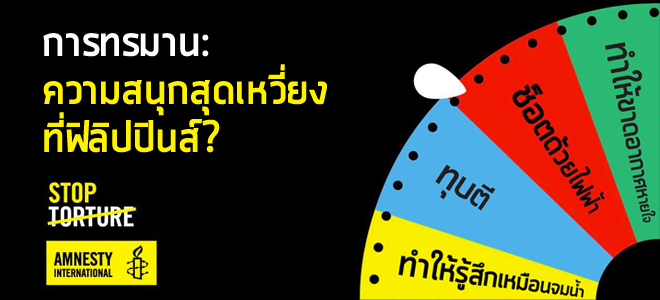3 February 2015
The popular game show “Wheel of Fortune” is a global phenomenon. Syndicated across more than 50 countries worldwide, millions have sat glued to their television screens as contestants try their luck with the spin of the wheel in eager anticipation of winning the star prize.
But this time last year in the Philippines, the “roleta ng kapalaran” (wheel of fortune) acquired notoriety with the gruesome discovery made by the Philippines’ Commission for Human Rights.
Tucked in a dark corner of a secret detention centre in the Laguna, a province south of the capital Manila, was a mock-up of the multicolour game show wheel. But rather than spinning for prizes and cash – it was used by police officers to decide how best to torture detainees for their own amusement.
One by one, detainees held in the centre would be taken out of their cells to another area in a secret detention facility where a police officer would spin the wheel and wait for a result.
A “30 second bat position” for example, meant that the detainee would be hung upside down like a bat for 30 seconds. A “20 second Manny Pacquiao” meant non-stop punches for 20 seconds.

Rowelito Almeda, 45, who endured four days of torture in the detention centre in January 2014, says he vividly remembers the terrifying wheel.
“I first saw it in the kitchen. Each time the police went on a drinking spree they would bring some detainees out of their cells and use the roulette wheel on them,” he said to Amnesty International.
Rowelito narrowly escaped the wheel when a team from the country’s Commission on Human Rights came to his rescue.
“Had they not arrived, I would have been next. One detainee told me, ‘Taryado ka na.’ When you say ‘taryado ka na’ that means you’re due for the roulette wheel.”
After it was discovered, the wheel went missing.
An official investigation into its use resulted in ten police officers being relieved from their posts. But beyond this administrative sanction, none of them have been convicted in court.
The despicable use of the game show wheel is emblematic of the all-too-often use of torture in the country.
‘Part of the deal’
Rowelito was among the 43 detainees rescued from the secret detention facility. He told Amnesty International that while on his way out of a police station, a police officer smashed a helmet onto his face, breaking four of his front teeth. Later he was beaten repeatedly and given electric shocks. Police officers put a rag in his mouth, covered his face with tape and handcuffed him, as though preparing him for execution. He heard the police officers discussing – and later disagreeing—about “finishing him off”.
According to a recent investigation by Amnesty International the practice of torture is still rife in the Philippines.
Detainees in police custody have been subjected to electric shocks; systematic beatings, punching and kicking; striking with wooden batons or metal bars; burning with cigarettes; waterboarding; near-asphyxiation with plastic bags as almost “part of the deal”.
“What is so disturbing about the use of the torture wheel is that it shows how police actually derived pleasure from the torture they meted out. It illustrates how the heinous act of torture has become an activity which police officers carry out as if they are above the law, without any fear that they will be prosecuted,” said Hazel Galang-Folli, Southeast Asia Researcher at Amnesty International.
Despite the Philippines having ratified two key international anti-torture treaties and passed a progressive Anti-Torture Act five years ago, police officers found responsible of torturing detainees hardly ever face the courts, let alone serve time in prison. To date, not one torturer is known to have been convicted under the Act.
Amnesty International believes the lack of effective investigations, coupled with endemic corruption within the police force and the low number of prosecutions in cases of torture, result in a toxic recipe that discourages torture victims from reporting their ordeals.
Few people dare to file a complaint against the police, knowing they risk retribution, harassment or intimidation from officers themselves or hired thugs.
Those who do complain have to jump through a number of bureaucratic hoops where the rules and procedures are unclear and inconsistent. Of the very few complaints that reach the preliminary investigation level, most have been dismissed on a technicality.
After the Commission on Human Rights rescued Rowelito from the detention centre, he said the police attempted to strike a compromise agreement with him, in order to stop him from filing a complaint for the torture he suffered.
The police officers made Rowelito sign a document saying he would withdraw the torture complaint filed by the Commission on Human Rights on his behalf. He only decided to persist with his complaint when he learned that the police officers who detained him had commissioned someone to kill him. That someone turned out to be his cousin, who told him about the plan.
But international condemnation is achieving results. Following the publication of Amnesty International’s report “Above the law: Police torture in the Philippines” last month, the Philippine’s Senate opened an inquiry into police torture in the country at which Amnesty International testified.
At the inquiry, the Philippine National Police’s representative said he had no knowledge of the torture cases described in the report and he could not give concrete examples of any action by the police to end torture.
In response, the Senate Committee Chair required the police to examine Amnesty International’s report and submit their response along with information about programmes instituted by the police to address torture.


